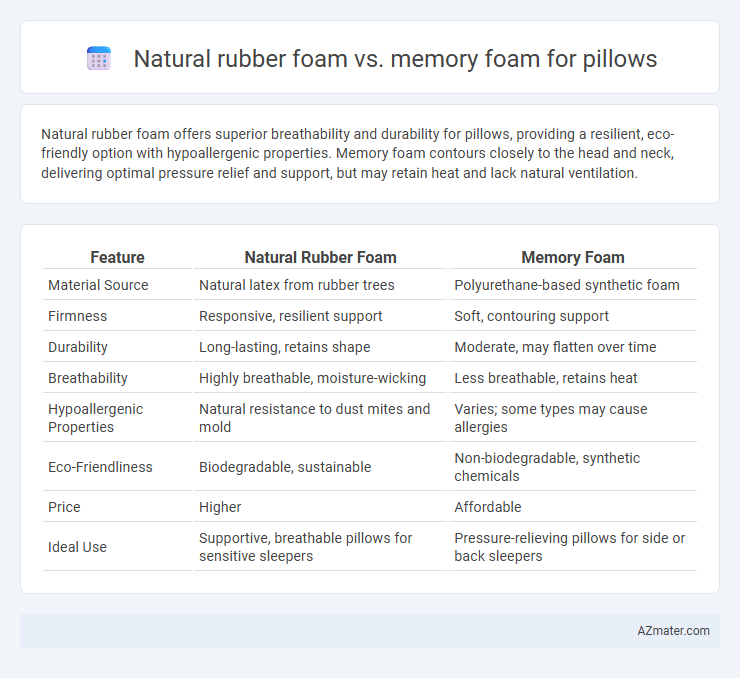Natural rubber foam offers superior breathability and durability for pillows, providing a resilient, eco-friendly option with hypoallergenic properties. Memory foam contours closely to the head and neck, delivering optimal pressure relief and support, but may retain heat and lack natural ventilation.
Table of Comparison
| Feature | Natural Rubber Foam | Memory Foam |
|---|---|---|
| Material Source | Natural latex from rubber trees | Polyurethane-based synthetic foam |
| Firmness | Responsive, resilient support | Soft, contouring support |
| Durability | Long-lasting, retains shape | Moderate, may flatten over time |
| Breathability | Highly breathable, moisture-wicking | Less breathable, retains heat |
| Hypoallergenic Properties | Natural resistance to dust mites and mold | Varies; some types may cause allergies |
| Eco-Friendliness | Biodegradable, sustainable | Non-biodegradable, synthetic chemicals |
| Price | Higher | Affordable |
| Ideal Use | Supportive, breathable pillows for sensitive sleepers | Pressure-relieving pillows for side or back sleepers |
Introduction to Natural Rubber Foam and Memory Foam
Natural rubber foam, derived from the sap of rubber trees, offers excellent elasticity, breathability, and hypoallergenic properties, making it a sustainable and eco-friendly choice for pillows. Memory foam, a synthetic polyurethane material infused with viscoelastic properties, contours to the head and neck for personalized support and pressure relief. Both foams provide unique comfort benefits, with natural rubber foam excelling in durability and ventilation, while memory foam is known for its superior body-conforming characteristics.
Key Differences Between Natural Rubber Foam and Memory Foam
Natural rubber foam offers superior breathability and natural antimicrobial properties compared to memory foam, which tends to retain heat and moisture. Memory foam excels in contouring to the body's shape, providing excellent pressure relief, while natural rubber foam maintains a more resilient and bouncy feel for enhanced support. Durability is higher in natural rubber foam due to its elastic structure, whereas memory foam may degrade faster under consistent use.
Comfort and Support Comparison
Natural rubber foam offers superior breathability and resilience, providing consistent support that adapts naturally to the head and neck's shape, reducing pressure points for enhanced comfort. Memory foam delivers excellent contouring by molding closely to individual curves, offering personalized support that alleviates pain and promotes spinal alignment. While natural rubber foam excels in responsiveness and durability, memory foam prioritizes deep cushioning and pressure relief for a softer sleeping experience.
Breathability and Temperature Regulation
Natural rubber foam pillows offer superior breathability and temperature regulation due to their open-cell structure, which allows air to circulate freely and prevents heat buildup. Memory foam, while conforming closely to the head and neck, tends to retain heat because of its denser material, often leading to a warmer sleep environment. Choosing natural rubber foam enhances airflow and maintains a cooler sleeping surface, making it ideal for hot sleepers seeking comfort and temperature control.
Durability and Longevity
Natural rubber foam pillows offer superior durability and longevity due to their resilient cellular structure, maintaining shape and support for over 10 years without significant degradation. Memory foam pillows typically last 3 to 5 years before they lose elasticity and develop permanent indentations, reducing comfort and spinal alignment. The hypoallergenic and antimicrobial properties of natural rubber further enhance its lifespan by preventing mold and bacterial growth, unlike memory foam, which can retain moisture and allergens over time.
Allergy Concerns and Hypoallergenic Properties
Natural rubber foam is inherently resistant to dust mites, mold, and bacteria, making it an excellent choice for allergy sufferers due to its hypoallergenic properties. Memory foam, while conforming to the body for comfort, can trap allergens and harbor dust mites if not properly maintained, potentially exacerbating allergy concerns. Choosing pillows made from natural rubber foam provides better protection against common allergens and supports a cleaner, more hypoallergenic sleeping environment.
Environmental Impact and Sustainability
Natural rubber foam is derived from the sap of rubber trees, making it a biodegradable and renewable material with a lower carbon footprint compared to synthetic memory foam, which is petroleum-based and non-biodegradable. The cultivation of rubber trees supports sustainable forestry practices and carbon sequestration, whereas memory foam production involves high energy consumption and releases volatile organic compounds (VOCs). Natural rubber foam pillows contribute to eco-friendly living by reducing landfill waste and minimizing chemical pollutants, positioning them as a more sustainable choice for environmentally conscious consumers.
Maintenance and Care Tips
Natural rubber foam pillows require gentle cleaning with mild soap and air drying to maintain their elasticity and prevent mold growth, while avoiding direct sunlight exposure. Memory foam pillows should be spot cleaned using a damp cloth and allowed to dry thoroughly to preserve their viscoelastic properties and prevent bacterial buildup. Both types benefit from using pillow protectors for extended durability and hygiene.
Price Differences and Value for Money
Natural rubber foam pillows typically cost more upfront due to the sustainable sourcing and durability of latex, offering excellent resilience and hypoallergenic properties that justify the higher price. Memory foam pillows, generally more affordable, provide superior contouring support by closely adapting to head and neck shapes but may lack breathability and long-term durability. Evaluating value for money depends on prioritizing natural materials and longevity versus initial affordability and personalized comfort.
Which Pillow Foam Should You Choose?
Natural rubber foam offers excellent breathability, durability, and natural resilience, making it ideal for those seeking eco-friendly and hypoallergenic pillow options. Memory foam contours closely to the head and neck, providing pressure relief and individualized support, especially beneficial for side and back sleepers. Choosing between natural rubber foam and memory foam depends on your preference for firmness, temperature regulation, and environmental impact.

Infographic: Natural rubber foam vs Memory foam for Pillow
 azmater.com
azmater.com